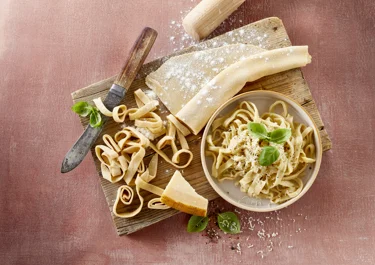Homemade pasta

Making homemade pasta is a great way to enjoy an authentic Italian experience at home. You require only a few ingredients and since it may be prepared without a machine, the process is quite easy. Because fresh, homemade pasta is more flavourful and tender than dried pasta, it makes for a delicious addition to any meal. It may be served with a variety of sauces and sides to create the perfect Italian homecooked meal.
Ingredients
|
Tipo 00 flour
|
300 g |
|---|---|
|
Eggs
|
3 |
|
Olive oil
|
1 tbsp |
|
Fine salt
|
1 tsp |
|
Tipo 00 flour, for rolling out the dough
|
25 g |
Instructions
Recommended information
Serving suggestion
Tips
An easy way to combine your dough according to a traditional homemade pasta recipe is to do so on a clean countertop as this gives you more space to work it. Create a well in the middle of the flour mount and crack the eggs into it. With a fork beat them until smooth. Then use your fingertips to mix the eggs and flour. Incorporate the flour into the egg mixture at a time until it has all been combined.
Tips
Start kneading pieces of dough together. Do not worry if you do not immediately have one single lump of dough – you will get there! Once combined, it is important to work it well to develop the flour's gluten and make the dough smooth and silky. This is what ensures Italian homemade pasta with a perfect bite that is neither soft nor tough and chewy.
Questions about homemade pasta
With a simple recipe for homemade pasta, making it at home is both fun and easy. To learn more about it, read our answers to the most frequently asked questions about it below.
How to make homemade pasta?
Homemade pasta is the perfect basis for comfort food that you can make easily at home. To do so, mix Tipo 00 wheat flour, eggs, olive oil, and salt. Knead for 10 minutes, until the dough is shiny and pliable, then rest it for 30 minutes. Divide it into two smaller portions and roll out each part on a floured countertop. Dust with flour, roll up and cut into thin strips. Cooking homemade pasta in salted water for 3-5 minutes will give it the perfect al dente texture. Serve with your favourite sauce, toppings, or side dishes.
Why is my homemade pasta tough or chewy?
Homemade pasta can sometimes turn out tough or chewy for a few reasons. Firstly, the dough may not have been kneaded enough, causing it to be too dense. Secondly, the dough may have been rolled out either too thin or too thick, leading to uneven cook. Thirdly, undercooking it can also result in a tough texture. To avoid these issues, knead the dough thoroughly, roll it out evenly, and cook it al dente.
What flour is best for homemade pasta?
The best flour for homemade pasta is Tipo 00 flour. This finely ground flour is made from high-quality wheat, and its low protein content and fine texture make it perfect for pasta-making. Tipo 00 flour produces a smooth, silky dough that is easy to work with and yields a tender, delicate pasta texture when cooked. You can also make homemade pasta with semolina flour or all-purpose flour, but Tipo 00 flour is the preferred choice for many professional pasta makers and foodies alike as the texture becomes tenderer which is preferable with, for example, fettuccine and tagliatelle. For a firmer texture (e.g., rigatoni), though, many prefer semolina.
How to dry homemade pasta?
Drying homemade pasta ensures it holds its shape better when cooked and keeps for longer. To dry it, cut it into strips and place them on a baking tray or a floured surface. Make sure to space them out to prevent sticking (you can use a drying rack for ease). Allow it to dry for 15 minutes before cooking it to give it a slightly firmer texture when cooked. To dry it for storage and preservation, you will need to let it dry out for 24 hours in a cool, dry place to thoroughly dehydrate it. Keep it lightly coated with flour and turn it in every few hours. Store it in a cool place in an airtight container for 6 months.
How to store homemade pasta?
If you dry homemade pasta, it will keep for up to 6 months in an airtight container in a cool, dry place. This way, it will maintain its shape and texture for much longer than fresh pasta. Fresh, it can be stored in the fridge for up to 48 hours. Wrap it tightly in cling film or place it in an airtight container to protect it from moisture and air to prevent it from becoming stale or mouldy.
How long does homemade pasta last?
Fresh homemade pasta, when stored properly, can last for up to 48 hours in the fridge. When storing it in the fridge, it is important to wrap it tightly in cling film or place it in an airtight container. Note that the freshness of the ingredients used and the level of moisture in the dough can affect its shelf life, so it is always best to use it as soon as possible for optimal flavour and texture. Drying it out will prolong its shelf life considerably so if you do plan on eating it immediately, consider drying or freezing it.
Can you freeze homemade pasta?
Yes, you can. To freeze it, transfer the dried homemade pasta to a lined baking tray and place it in the freezer. Once it is frozen, transfer it to a freezer-safe airtight container or bag and store it in the freezer for up to 6 months. When ready to use, bring a pot of salted water to a boil and add the frozen pasta. Cook for a few minutes until it floats to the surface and is cooked to your desired texture. Frozen homemade pasta may take slightly longer to cook than fresh, so keep an eye on it.
Easy homemade pasta – get the Italian experience at home
Homemade pasta made has a delicate and slightly nutty flavour that is characteristic of the high-quality Tipo 00 wheat flour used in it. The eggs add richness to the dough and give it a subtle yellowish colour, while the olive oil tenderises the dough and ensures a smooth, silky texture.
When cooked al dente, fresh pasta has a delicate, tender, and slightly chewy texture with a smooth mouthfeel that is unlike dried pasta. Homemade pasta is also more flavourful, as it does not contain any additives or preservatives that can mask its taste. The taste is not overly pronounced, though, allowing you to pair it with a variety of different sauces, toppings, and sides to great success.
Simple ingredients and quick preparation without a machine
Making homemade pasta from scratch is quite simple and requires just a few simple ingredients. With our recipe, you do not need any specialised equipment like a fancy pasta machine. Using your hands and a rolling pin, you can easily make this at home. It can be a fun and satisfying experience, and it is a great way to impress family and friends with your culinary skills.
When making something this simple, choosing only high-quality ingredients is of the essence. High-quality flour and olive oil ensure a wonderful texture and great flavour, and when you have that in your pantry, it is easy to convince yourself to make this every so often and pamper family and friends with this true crowd-pleaser.
Serve with delicious sauces and side dishes
Homemade pasta tastes great with a variety of sauces and side dishes. Use it for classic, flavourful spaghetti bolognese, chicken spaghetti with herby thyme tomatoes and salty salad cheese, or decadently creamy spaghetti carbonara. It also tastes wonderful with pork, beef, fish, and shellfish, for example, in a tomato-based sauce for a classic spaghetti marinara.
If you want to keep it simple, the perhaps most popular sauce for homemade pasta is sweet-tangy tomato sauce. When paired with a hard, salty cheese like Pecorino and Parmesan, the combination of flavours is irresistible. Another popular choice is to make a simple lemon butter sauce with garlic to pour over the pasta. This sauce works great with options like fresh peas or delicate shrimp.
Experiment with different homemade pasta shapes and flavours
The best homemade pasta recipe can be used to make a variety of different kinds of pasta. While we have advised you on how to make fettuccine-like pasta, you can, of course, also cut the dough into wider strips to make tagliatelle or pappardelle. You can also do thin ribbons to make spaghetti.
If you want more of a challenge, you can make short pasta types like the small, twisted spirals called rotini, the small cup-like shapes referred to as orecchiette or the decorative bow-like pasta known as farfalle.
You can also add different flavours to the dough. Add, for example, different herbs or spices to the dough, such as fresh or dried basil, oregano, thyme, or black pepper.
You can also incorporate ingredients like spinach, tomato paste, or squid ink into the dough for added colour and flavour. Try spinach pasta with its slightly earthy taste and vibrant green colour, tomato paste pasta with a subtle sweet-tangy tomato flavour and a warm reddish hue, or savoury, slightly briny squid ink pasta with a striking black colour.









